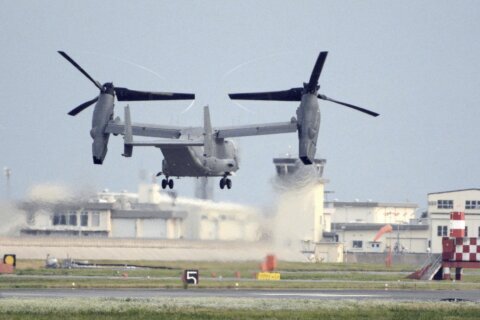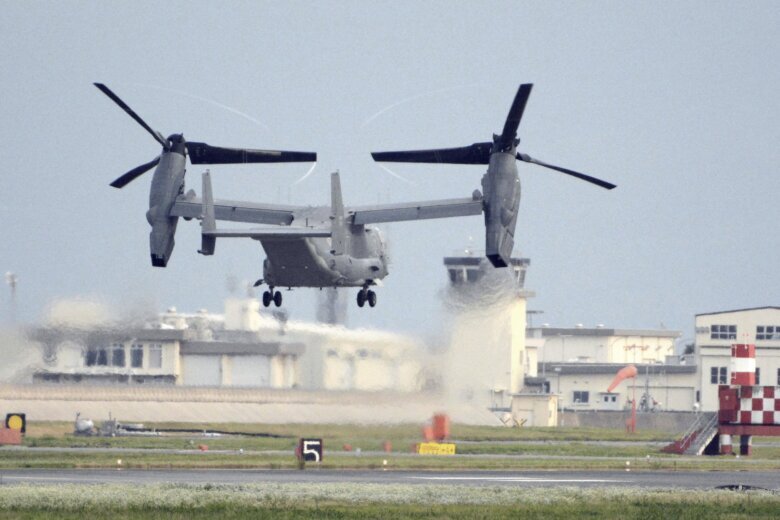
TOKYO (AP) — Japan suspended flights by its Osprey aircraft Thursday, officials said, the day after a U.S. Air Force Osprey based in Japan crashed into the sea during a training mission.
Tokyo said it also asked the U.S. military to ground all Ospreys operating in Japan except for those joining the search operations at the crash site. At least one of the eight crew members aboard was killed, but the status of the others was not yet known.
But the Pentagon said U.S. Ospreys continue to operate out of Japan. The deputy press secretary, Sabrina Singh, said she was not aware of an official request from Japan to freeze Osprey flights.
A senior defense ministry official, Taro Yamato, told a parliamentary hearing that Japan has suspended flights of Ospreys until details of the crash and safety are confirmed. The cause of Wednesday’s crash was not yet known.
The U.S.-made Osprey is a hybrid aircraft that takes off and lands like a helicopter but can rotate its propellers forward and cruise much faster, like an airplane, during flight.
Ministry officials said a planned training flight Thursday at the Metabaru army camp in the Saga prefecture in southern Japan was canceled as part of the grounding of all 14 Japanese-owned Ospreys deployed at Japan’s Ground Self-Defense Force bases.
“The occurrence of such a major accident causes great anxiety to the people of the region and it is truly regrettable,” Defense Minister Minoru Kihara said in a parliamentary hearing Thursday. “We have requested the U.S. side to conduct flights of Ospreys deployed in Japan after their flight safety is confirmed,” he said. His language was vague and did not clearly say that all Ospreys should be stood down.
Defense officials said they hoped the U.S. side got the message, but NHK national television said a number of Ospreys flew in and out of a U.S. air base on Okinawa. One U.S. Osprey has joined the rescue operation off Japan’s southern coast, defense officials said.
A U.S. defense official said if there was a pause in flights, it could also be to allow the small Air Force Special Operations Command community in Japan time to process its unit’s crash, the official said. The official spoke on the condition of anonymity to discuss sensitive details about the crash.
The coast guard, as well as Japanese troops, searched through the night, and on Thursday the coast guard started using sonar to search underwater for the broken aircraft, which might have sunk to the sea bottom, at a depth of about 30 meters (100 feet).
Ospreys have had a number of crashes, including in Japan, where they are used at U.S. and Japanese military bases, and the latest crash rekindles safety concerns and controversy over the deployment in Japan. In Okinawa, where about half of the 50,000 American troops are based, Gov. Denny Tamaki had said he would ask the U.S. military to suspend all Osprey flights in Japan.
On Thursday, Japanese Foreign Minister Yoko Kamikawa met with U.S. Ambassador to Japan Rahm Emanuel at her ministry, asking the United States “to promptly provide information to the Japanese side.” Emanuel said the focus now is the search for the missing crew members and he thanked Japanese troops, coast guard and local fishermen for “being side by side.”
NHK public television and other news outlets reported that the aircraft had requested an emergency landing at the Yakushima airport about five minutes before it was lost from radar. NHK quoted a Yakushima resident saying he saw the aircraft turn upside down, with fire coming from one of its engines, and then an explosion before it fell into the sea.
U.S. Air Force Special Operations Command said the CV-22B Osprey was one of six deployed to Yokota Air Base, home to U.S. Forces Japan and the Fifth Air Force, and assigned to the 353rd Special Operations Wing.
The aircraft had departed from the U.S. Marine Corps Air Station Iwakuni in Yamaguchi prefecture and crashed on its way to Kadena Air Base on Okinawa, Japanese officials said.
Last year, Air Force Special Operations Command ordered a temporary stand-down of its Osprey fleet following back-to-back safety incidents where the Osprey clutch slipped, causing an uneven distribution of power to its rotors.
The Marine Corps and Navy have reported similar clutch slips, and each service has worked to address the issue in their aircraft, however clutch failure was also cited in a 2022 fatal U.S. Marine Corps Osprey crash that killed five.
According to the investigation of that crash, “dual hard clutch engagement” led to engine failure.
Separately, a U.S. Marine Corps Osprey with 23 Marines aboard crashed on a northern Australian island in August, killing three Marines and critically injuring at least five others who were taking part in a multinational training exercise.
___
Lolita Baldor contributed to this report. Baldor and Copp reported from Washington.
Copyright © 2024 The Associated Press. All rights reserved. This material may not be published, broadcast, written or redistributed.








